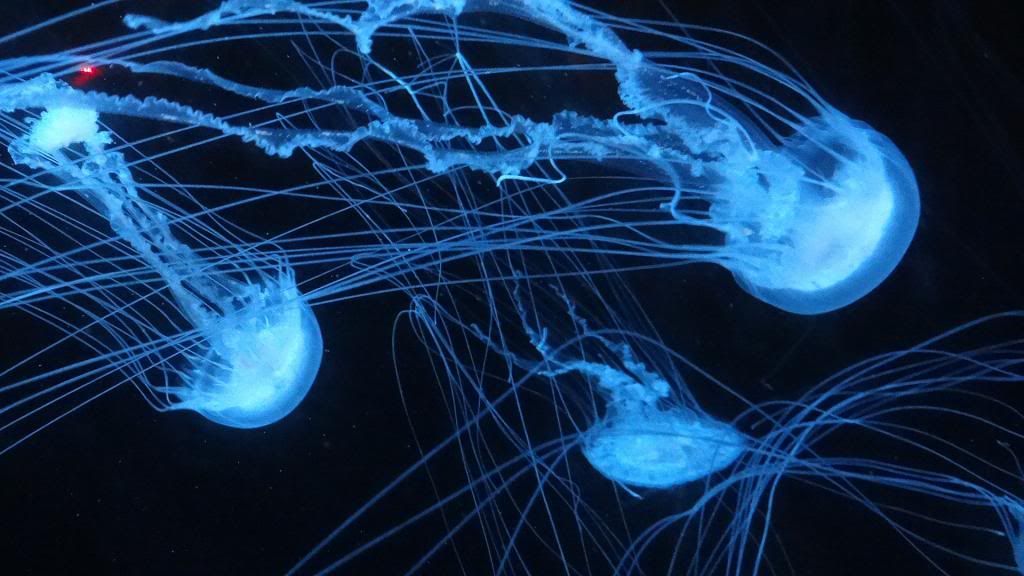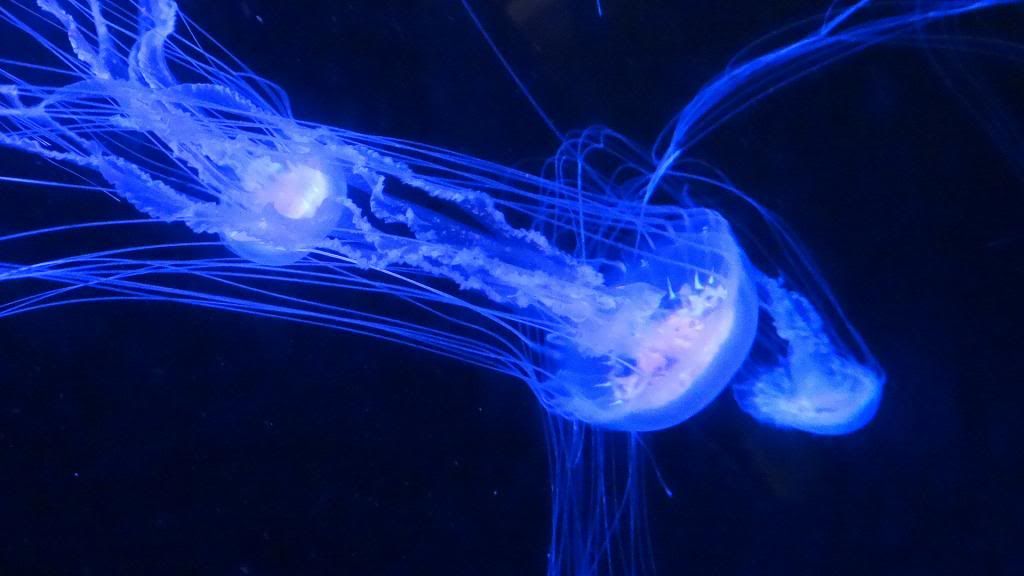Jellyfish, 270513, Chicago, Shedd Aquarium
On a recent visit to Chicago, I went to visit the famous
Of the many water creatures that I saw there, some of the most beautiful, and ethereal, were the
Jellyfish, sometimes called “jellies” are the major non-polyp form of individuals of the phylum Cnidaria. They are typified as free-swimming marine animals consisting of a gelatinous umbrella-shaped bell and trailing tentacles. The bell can pulsate for locomotion, while stinging tentacles can be used to capture prey.
Cnidaria? How does one even pronounce that? Easier to just watch these beings float across the water..
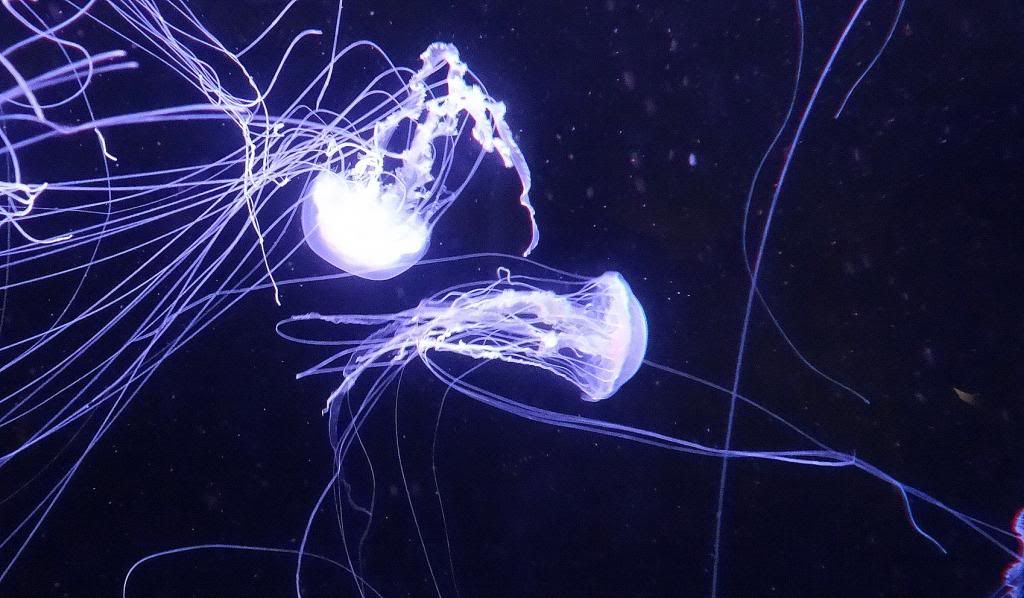 Jellyfish are mainly to be found in seawater, but there are some freshwater varieties, too.
Jellyfish are mainly to be found in seawater, but there are some freshwater varieties, too.
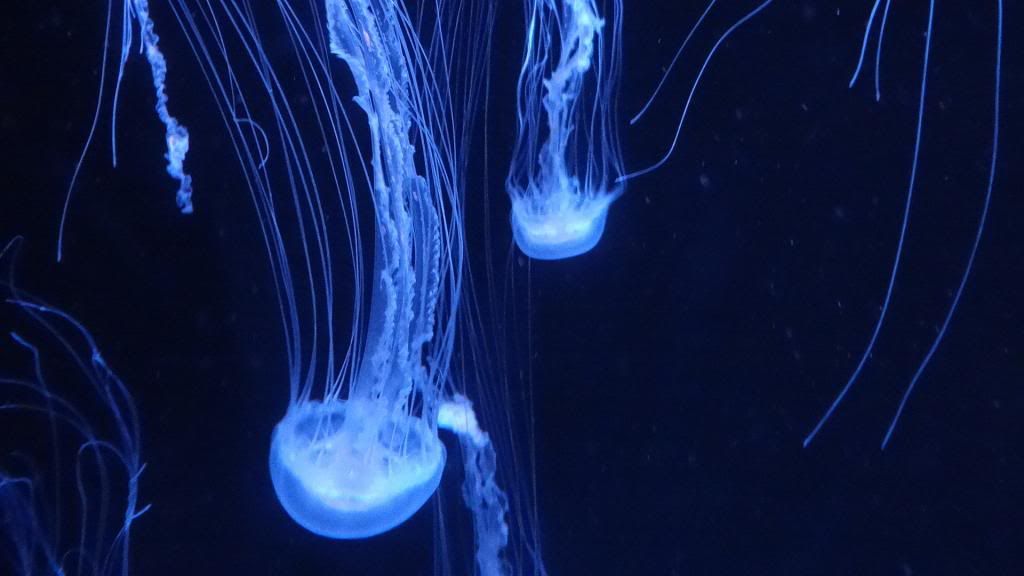 Jellyfish roamed the seas for at least 500 million years, and possibly 700 million years or more, making them the oldest multi-organ animal. Wow! Jellies are older than I am!
Jellyfish roamed the seas for at least 500 million years, and possibly 700 million years or more, making them the oldest multi-organ animal. Wow! Jellies are older than I am!
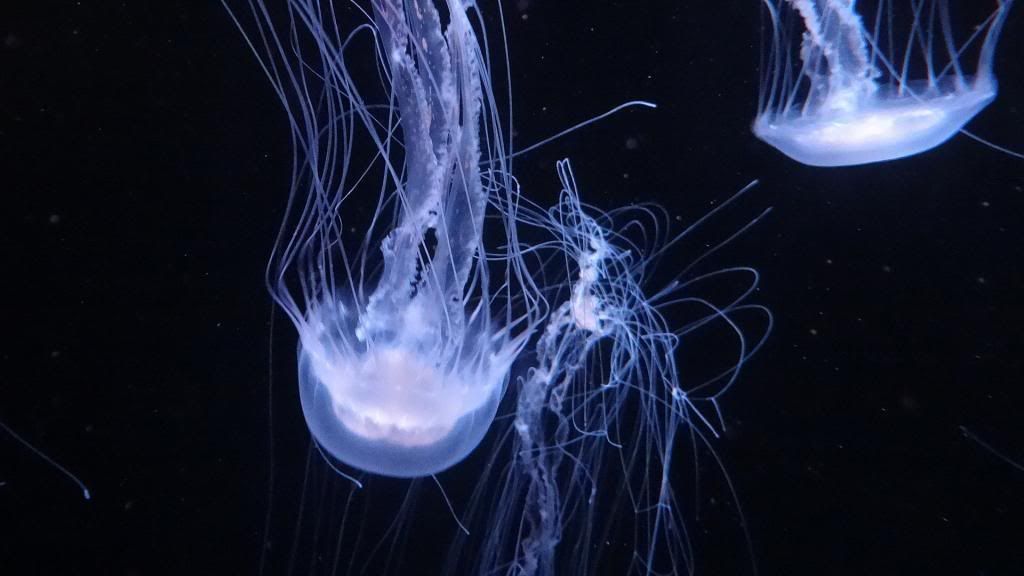 The name "jellyfish" is itself the subject of debate. As jellyfish are not vertebrates, let alone true fish, the word jellyfish is considered by some to be a misnomer. Public aquariums may use the terms jellies or sea jellies instead. Indeed, it may be said that the term "jellies" has become more popular than "jellyfish". In scientific literature, "jelly" and "jellyfish" are often used interchangeably.[Some sources may use the term "jelly" to refer to organisms in this taxon, as "jellyfish" may be considered inappropriate.
The name "jellyfish" is itself the subject of debate. As jellyfish are not vertebrates, let alone true fish, the word jellyfish is considered by some to be a misnomer. Public aquariums may use the terms jellies or sea jellies instead. Indeed, it may be said that the term "jellies" has become more popular than "jellyfish". In scientific literature, "jelly" and "jellyfish" are often used interchangeably.[Some sources may use the term "jelly" to refer to organisms in this taxon, as "jellyfish" may be considered inappropriate.
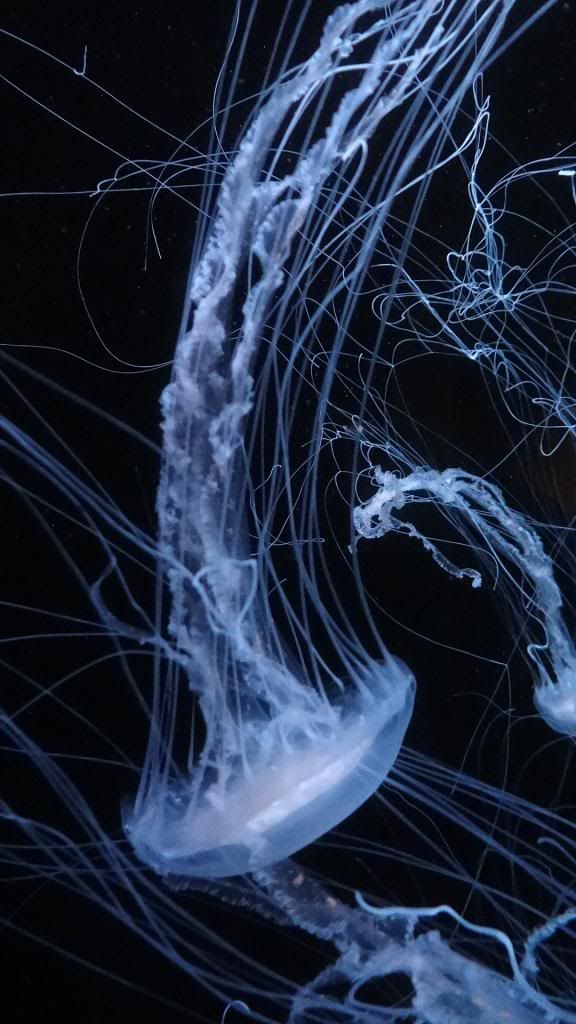 Amazingly, most jellyfish do not have specialized digestive, osmoregulatory, central nervous, respiratory, or circulatory systems. The manubrium is a stalk-like structure hanging down from the centre of the underside, with the mouth at its tip. This opens into the gastrovascular cavity, where digestion takes place and nutrients are absorbed. It is joined to the radial canals which extend to the margin of the bell. Jellyfish do not need a respiratory system since their skin is thin enough that the body is oxygenated by diffusion. They have limited control over movement, but can use their hydrostatic skeleton to navigate through contraction-pulsations of the bell-like body; some species actively swim most of the time, while others are mostly passive.
Amazingly, most jellyfish do not have specialized digestive, osmoregulatory, central nervous, respiratory, or circulatory systems. The manubrium is a stalk-like structure hanging down from the centre of the underside, with the mouth at its tip. This opens into the gastrovascular cavity, where digestion takes place and nutrients are absorbed. It is joined to the radial canals which extend to the margin of the bell. Jellyfish do not need a respiratory system since their skin is thin enough that the body is oxygenated by diffusion. They have limited control over movement, but can use their hydrostatic skeleton to navigate through contraction-pulsations of the bell-like body; some species actively swim most of the time, while others are mostly passive.
 Another incredible fact is that the body is composed of over 95% water; most of the umbrella mass is a gelatinous material — the jelly — called mesoglea which is surrounded by two layers of protective skin. The top layer is called the epidermis, and the inner layer is referred to as gastrodermis, which lines the gut.
Another incredible fact is that the body is composed of over 95% water; most of the umbrella mass is a gelatinous material — the jelly — called mesoglea which is surrounded by two layers of protective skin. The top layer is called the epidermis, and the inner layer is referred to as gastrodermis, which lines the gut.
 Can jellyfish "feel"? Jellyfish employ a loose network of nerves, located in the epidermis, which is called a "nerve net". Although traditionally thought not to have a central nervous system, nerve net concentration and ganglion-like structures could be considered to constitute one in most species.A jellyfish detects various stimuli including the touch of other animals via this nerve net.
Their "vision", too, is different....Some jellyfish have ocelli: light-sensitive organs that do not form images but which can detect light, and are used to determine up from down, responding to sunlight shining on the water's surface. These are generally pigment spot ocelli, which have some cells (not all) pigmented.
Can jellyfish "feel"? Jellyfish employ a loose network of nerves, located in the epidermis, which is called a "nerve net". Although traditionally thought not to have a central nervous system, nerve net concentration and ganglion-like structures could be considered to constitute one in most species.A jellyfish detects various stimuli including the touch of other animals via this nerve net.
Their "vision", too, is different....Some jellyfish have ocelli: light-sensitive organs that do not form images but which can detect light, and are used to determine up from down, responding to sunlight shining on the water's surface. These are generally pigment spot ocelli, which have some cells (not all) pigmented.
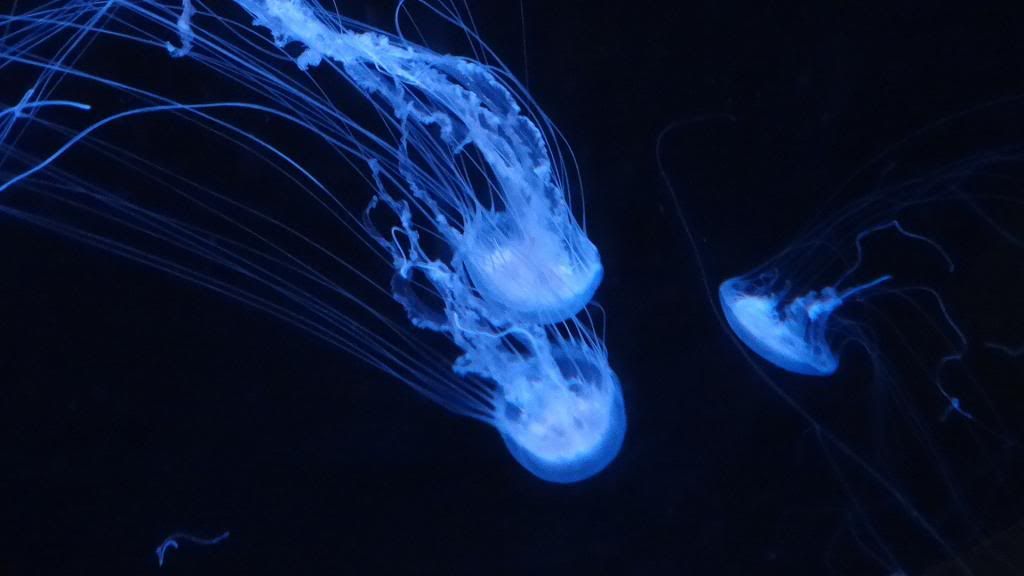 Certain species of jellyfish, such as the box jellyfish, have been revealed to be more advanced than their counterparts. The box jellyfish has 24 eyes, two of which are capable of seeing color, and four parallel information processing areas or rhopalia that act in competition,supposedly making it one of the few creatures to have a 360-degree view of its environment.The eyes are suspended on stalks with heavy crystals on one end, acting like a gyroscope to orient the eyes skyward. They look upward to navigate.
Certain species of jellyfish, such as the box jellyfish, have been revealed to be more advanced than their counterparts. The box jellyfish has 24 eyes, two of which are capable of seeing color, and four parallel information processing areas or rhopalia that act in competition,supposedly making it one of the few creatures to have a 360-degree view of its environment.The eyes are suspended on stalks with heavy crystals on one end, acting like a gyroscope to orient the eyes skyward. They look upward to navigate.
 Their sizes vary widely. Jellyfish range from about one millimeter in bell height and diameter to nearly two meters in bell height and diameter; the tentacles and mouth parts usually extend beyond this bell dimension.
Their sizes vary widely. Jellyfish range from about one millimeter in bell height and diameter to nearly two meters in bell height and diameter; the tentacles and mouth parts usually extend beyond this bell dimension.
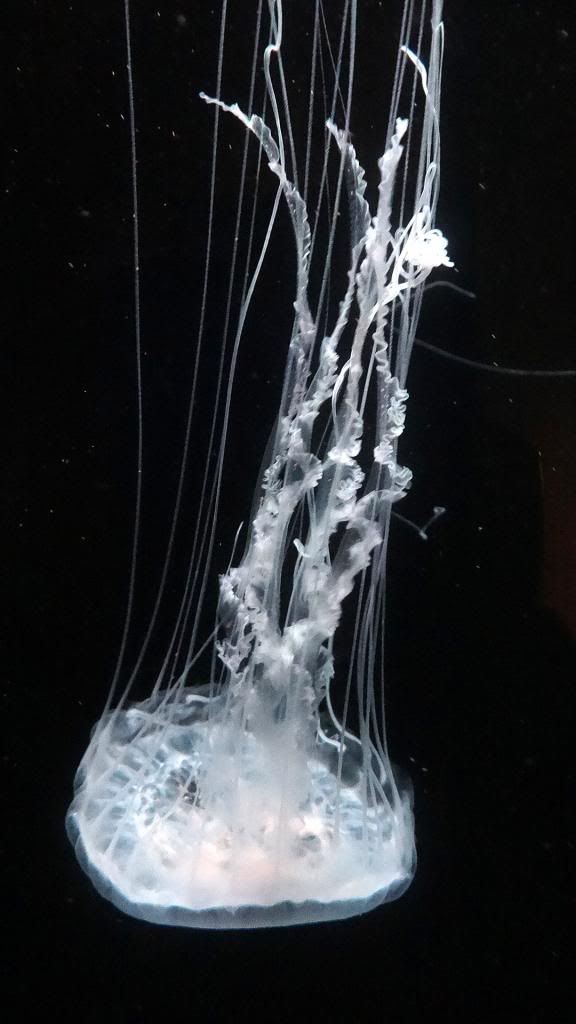 Most jellyfish alternate between polyp and medusa generations during their life cycle. Additionally, there are several possible larval life-stages. Their reproduction, too, is amazing..it's both sexual and asexual! Upon reaching adult size, jellyfish spawn daily if there is enough food. In most species, spawning is controlled by light, so the entire population spawns at about the same time of day, often at either dusk or dawn.[42] Jellyfish are usually either male or female (hermaphroditic specimens are occasionally found).
Most jellyfish alternate between polyp and medusa generations during their life cycle. Additionally, there are several possible larval life-stages. Their reproduction, too, is amazing..it's both sexual and asexual! Upon reaching adult size, jellyfish spawn daily if there is enough food. In most species, spawning is controlled by light, so the entire population spawns at about the same time of day, often at either dusk or dawn.[42] Jellyfish are usually either male or female (hermaphroditic specimens are occasionally found).
 And here's the most amazing factoid of all..some varieties of jellies are immortal! Jellyfish lifespans typically range from a few hours to several months. Life span and maximum size varies by species. Jellyfish held in public aquariums are carefully tended, and so may live several years, though this would be very unusual in the sea. Most large coastal jellyfish live 2 to 6 months, during which they grow from a millimeter or two to many centimeters in diameter. One unusual species is reported to live as long as 30 years. Another unusual species, T. nutricula, might be effectively immortal because of its ability under certain circumstances in the laboratory to transform from medusa back to the polyp stage, thereby escaping death!
And here's the most amazing factoid of all..some varieties of jellies are immortal! Jellyfish lifespans typically range from a few hours to several months. Life span and maximum size varies by species. Jellyfish held in public aquariums are carefully tended, and so may live several years, though this would be very unusual in the sea. Most large coastal jellyfish live 2 to 6 months, during which they grow from a millimeter or two to many centimeters in diameter. One unusual species is reported to live as long as 30 years. Another unusual species, T. nutricula, might be effectively immortal because of its ability under certain circumstances in the laboratory to transform from medusa back to the polyp stage, thereby escaping death!
 Jellies are carnivorous, feeding on plankton, crustaceans, fish eggs, small fish and other jellyfish, ingesting and voiding through the same hole in the middle of the bell. Jellies hunt passively using their tentacles as drift nets. Some jellies can have a toxic sting, too. Jellyfish stings range from a twinge to tingling to agony. Most jellyfish stings are not deadly, but stings of the Box jellyfish, such as the famous and especially toxic Irukandji jellyfish, can be deadly
Jellies are carnivorous, feeding on plankton, crustaceans, fish eggs, small fish and other jellyfish, ingesting and voiding through the same hole in the middle of the bell. Jellies hunt passively using their tentacles as drift nets. Some jellies can have a toxic sting, too. Jellyfish stings range from a twinge to tingling to agony. Most jellyfish stings are not deadly, but stings of the Box jellyfish, such as the famous and especially toxic Irukandji jellyfish, can be deadly
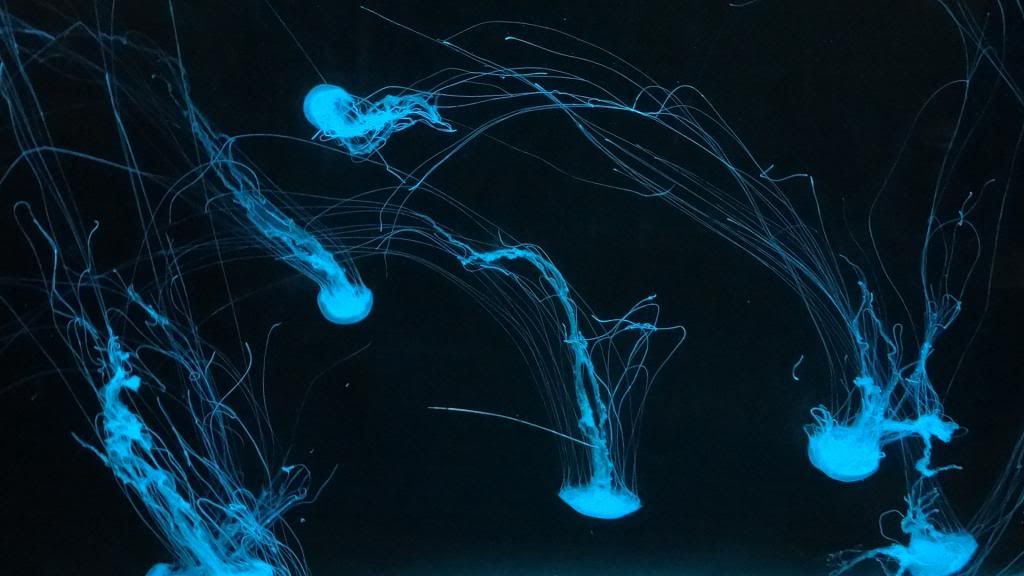 Their enemies? Other species of jellyfish are among the most common and important jellyfish predators, some of which specialize in jellies. Other predators include tuna, shark, swordfish, sea turtles and at least one species of Pacific salmon. Sea birds sometimes pick symbiotic crustaceans from the jellyfish bells near the sea's surface.
Of course, we are enemies to jellies, too. In some countries, such as Japan, jellyfish are known as a delicacy. "Dried jellyfish" has become increasingly popular throughout the world. The jellyfish is dried to prevent spoiling; if not dried they can spoil within a matter of hours. Once dried, they can be stored for weeks at a time.
I do not know exactly which species of jellyfish I have photographed. The light in the enclosure changed from blues to violets, and I tried clicking them as they rapidly moved through the water with other-wordly grace. Indeed, the word "other-worldly" is very appropriate..this marine world is one which most of us will never enter in our lives! The jellies I photographed had such long tentacles; they seemed to entangle themselves in each other and with the tentacles of the "bloom" (group of jellies)...and I saw several severed pieces of tentacles, too. Apparently, jellyfish are displayed in many public aquaria. Often the tank's background is blue and the animals are illuminated by side light, increasing the contrast between the animal and the background. In natural conditions, many jellies are so transparent that they are nearly invisible.
Their enemies? Other species of jellyfish are among the most common and important jellyfish predators, some of which specialize in jellies. Other predators include tuna, shark, swordfish, sea turtles and at least one species of Pacific salmon. Sea birds sometimes pick symbiotic crustaceans from the jellyfish bells near the sea's surface.
Of course, we are enemies to jellies, too. In some countries, such as Japan, jellyfish are known as a delicacy. "Dried jellyfish" has become increasingly popular throughout the world. The jellyfish is dried to prevent spoiling; if not dried they can spoil within a matter of hours. Once dried, they can be stored for weeks at a time.
I do not know exactly which species of jellyfish I have photographed. The light in the enclosure changed from blues to violets, and I tried clicking them as they rapidly moved through the water with other-wordly grace. Indeed, the word "other-worldly" is very appropriate..this marine world is one which most of us will never enter in our lives! The jellies I photographed had such long tentacles; they seemed to entangle themselves in each other and with the tentacles of the "bloom" (group of jellies)...and I saw several severed pieces of tentacles, too. Apparently, jellyfish are displayed in many public aquaria. Often the tank's background is blue and the animals are illuminated by side light, increasing the contrast between the animal and the background. In natural conditions, many jellies are so transparent that they are nearly invisible.
What amazing creatures populate this Earth! Between the land, the water and the air, there will never be an end to the wonders that Nature provides.
If all these photos are not enough, you can see my FaceBook album

